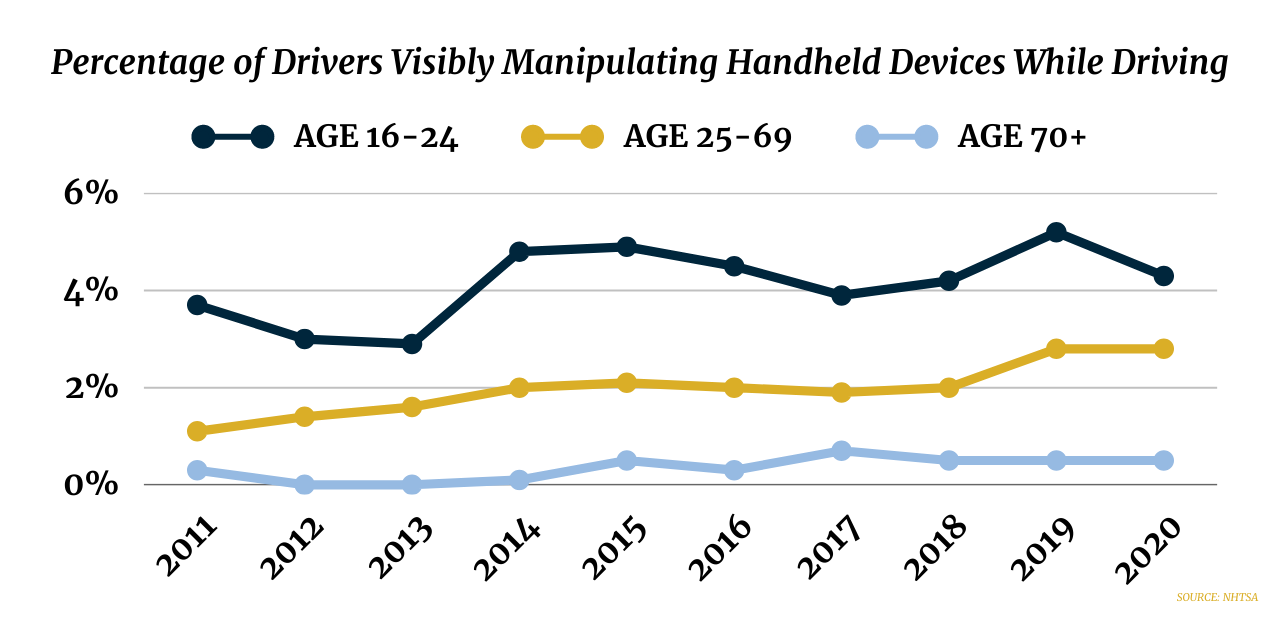April is National Distracted Driving Awareness Month
3,142
LIVES LOST IN CRASHES INVOLVING DISTRACTED DRIVERS (2020)
8%
FATAL CRASHES IN THAT INVOLVED DISTRACTED DRIVERS (2020)
29,000
APPROX. NUMBER OF PEOPLE WHO DIED FROM DISTRACTED DRIVING (2012-2020)
THE MESSAGE
As many of you are already aware, April is Distracted Driving Awareness Month. Distracted driving is an ongoing epidemic in our country. This annual focus on distracted driving allows us an opportunity to emphasize safe driving habits and highlight roadway safety statistics to keep this important topic front of mind throughout April and beyond.
National Distracted Driving Awareness Month was formed to provide ongoing education in an effort to reduce the number of distractions behind the wheel. For many, use of a mobile device is integrated into their daily routine. Unfortunately, this also means these behaviors continue to take place everywhere – including behind the wheel. These unsafe actions not only endanger the driver, but also the motoring public with whom they share the road.
THE RESULTS
There were 31,785 fatal driving accidents reported during the first nine months of 2022 (*NHTSA). This represents 0.2% decrease in fatalities when compared to 2021 year-over-year data. Although these statistics illustrate a small improvement, we take no solace in the fact that thousands of lives are lost each year on our highways.
The good news is, when taking that 0.2% decrease in fatalities and conveying that information into an actual number of lives that were not lost in comparison to the prior year, the result is 638. These 638 people would not be going home to their family if we were tracking with the prior year fatal roadway accident numbers.
Whether this small decrease is from improved technology integrated into our automobiles or perhaps someone taking the time to read an article like this – it is worth mentioning we still have a long way to go. The numbing statistics of those who lose their lives on our roadways should serve as a constant reminder of how delicate life can be and how we each can make a difference.
The graph below depicts a study that shows the “Percentage of Drivers Visibly Manipulating Handheld Device While Driving”, which highlights those areas of opportunity by age groups.

I will say conservatively, from a risk management perspective, the actual number of distracted drivers is higher than what is yielded in any given study. Studies help bring awareness, but it is very difficult to quantify the true number of distracted drivers, hence we all need to focus on being better drivers behind the wheel and work to improve our driving habits. This can only happen if we invest the time to learn how to decrease risky behaviors while driving.
THE ASK
It is actions, not words, which create change. Even with 48 states, as well as D.C., Puerto Rico, Guam, and the U.S. Virgin Islands, having laws that completely ban text messaging while driving, texting while driving continues to represent one of the biggest risks encountered daily.
Taking the time to discuss this topic with your employees, family members, and friends can make a difference. If the message is delivered in a meaningful manner, it can change one’s mentality and hopefully behaviors while driving.
Distractions are all around us in our day-to-day lives, it is up to us to start making that change. From responding to important work messages to paying bills, we can do about anything we need to do with a few clicks on our phone. Both items noted above are important; however, there is a time and place to do complete those tasks – but it’s definitely not while behind the wheel.
The mission of making our highways safer and improving our driving habits resides in each of us. There are many ways to get started:
- Take the time to learn and incorporate the available technology that is out there, such as enabling the “Driving Focus” feature on your phone.
- If you are a driving employee, recommend that your employer implement a “Fleet Safety” program that requires drivers not to text and drive if not already in place.
- If you are a passenger, remind the driver that their responsibility is to get you there safely and not to use their phones while driving.
- Make distracted driving a routine part of conversations with friends, family, and co-workers.
Lastly, we find that one of the more impactful methods to becoming a better driver is to simply take a pledge and create accountability for you and others. For more information on taking the pledge, please visit sentinelra.com/rpg.


